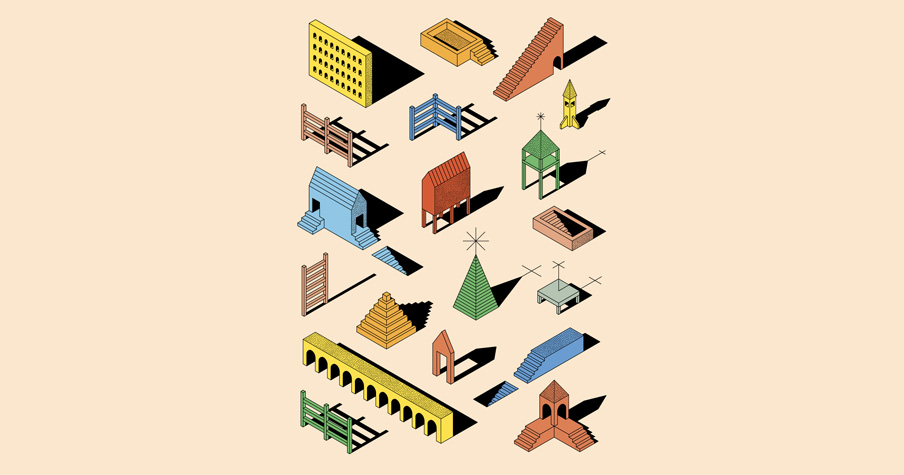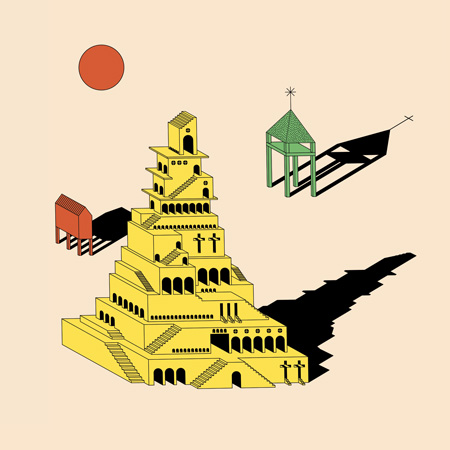
Illustrations by Irena Gajic
Libraries, and access to the information contained in them, have always been integral to theological education. Yet, how this information is stored and accessed has changed drastically over the millennia. The handwritten codex replaced the scroll, the printing press enabled mass production of Bibles and other theological materials, and the dissemination of books multiplied access manyfold. The printed book lowered the cost of acquisition dramatically, and universities filled their library collections with bound volumes.
Entering the modern era, photographic processes allowed large volumes of journals and other printed materials to be miniaturized for access on microfiche readers. With the advent of computers and the internet, catalog and index search, scanning for computer presentation, and search engines for full-text documents and manuscripts fundamentally changed the traditional library. Today, digital rights management allows libraries to buy digital licenses for books rather than adding additional printed material to their shelves.
Throughout these seismic shifts in technology, librarians have been tasked with acquiring, organizing and making accessible increasing amounts of data. And as the profession of librarian has advanced in recent decades, much of the innovation and scholarship has been centered in information sciences.
For today’s students and researchers in theological education, no library resource is more ubiquitous than the Atla databases. Atla (the American Theological Library Association) has been the de facto reference tool in theological schools for over 40 years. Access to the databases is licensed through EBSCO, Atla’s long-time technology and search tool partner, where subscribers mine millions of sources in their research.
As a member organization, Atla pairs its comprehensive database collection with the technology and training needed to best utilize these resources. More than 300 institutional members and 500 individual members participate in professional development and assist in research and development to advance theological and religious libraries. An annual convention brings members together for education and mutual support, along with member-staffed committees and working groups that guide the organization’s activities.
John Kutsko started as Atla’s executive director in December 2022 after 12 years as director and Chief Executive Officer of the Society of Biblical Literature. He and his staff are setting a direction for Atla that hinges on three key areas.
“First is for the database to become truly interdisciplinary and interprofessional,” he says. “Atla already has this curated database and now expanded into areas where we see the curriculum changing, such as interest in social work, law, nursing, or community planning.
“Second is the ability to become more consumer friendly. By that I mean students are being socialized to do quick searches – we just have to accept that – and so we need a user experience that provides a level of ease so that when faced with the decision to just do a Google search or to use a curated database of resources and references works, they choose Atla.”
The final goal is to create tools for ATS (Association of Theological Schools) institutions, especially those with limited resources, allowing more schools to access Atla’s resources. “It’s part of our historic mission with ATS, and we’ve got to come back to that,” he says. “This relationship isn’t only how we were birthed, but it’s fundamental to our mission.”

The Proliferation of Data
As more data is available to search, theological institutions are particularly interested in how students and other researchers will access reliable data in their fields of study.
Current estimates are for 328 zettabytes (equivalent to 328 billion terabytes) of data to be generated by 2025. With more than 3.4 million bibliographic records in its database, Atla’s searchable information has grown apace. Since 2013, Atla has added 1.25 million records to its database – a number that is growing an average of 140,000 records per year (prior to 2015, only 50,000 records were added annually). Of the 1,330 indexed journal titles available in Atla searches, almost half have been added since 2015. Spanning a variety of world religions and interdisciplinary topics, the diversity of the database has grown to represent titles from 72 countries. Titles from 47 countries have been added since 2015.
This abundance of data creates more complexity for searching and how the results are presented, says Bo Adams, associate professor in the practice of theological bibliography and director of Pitts Theology Library at Emory’s Candler School of Theology. Rather than coming up with one right answer, or the limited set of answers traditional internet searches produce, library resource searches often provide more results with a variety of paths to follow.
“The information we’re trying to search has exploded in size and in context,” says Adams. “A very simplified view of search is doing a disservice not only to the patron but also to the complexity of information that we now have. We need to have search interfaces that push the patron to understand the complexity of the tasks we’re asking the computer to do and give them a recognition of the body of information that we’re searching, which is so much vaster than it used to.”
In addition to a library’s holdings, researchers have access to Atla, JSTOR, Google, ChatGPT, Wikipedia, and other academic databases. But Adams believes it’s often not clear to researchers why the library website or Atla is a better place to search than ChatGPT.
“If we librarians want to be honest with ourselves, it may not be a better place to search,” he says. “But we at least have to educate the patron to think about it. That job is even more important in this rapidly expanding information ecosphere.”
The final goal is to create tools for ATS (Association of Theological Schools) institutions, especially those with limited resources.
Benefits for Distance Learning
The growth of online accessible data couldn’t have come at a better time, given trends in distance learning. A 2023 report by the National Center for Education Statistics noted that 42 percent of post-baccalaureate students in 2019 were enrolled in at least one distance education course while 33 percent of students were enrolled exclusively in distance education courses. These percentages ballooned to 71 and 52 percent respectively in 2020 during the pandemic, before recovering to 56 and 40 percent as face-to-face education resumed.
Theological librarians are keenly aware of the demands from distance learning and the need for expanded digital utilization and access to research materials.
“The pivoting that had to happen with document delivery really came into theological libraries during COVID and the pandemic,” says Kelly Campbell, associate dean of information services and senior director of the John Bulow Campbell Library at Columbia Theological Seminary in Decatur, Georgia, just outside of Atlanta.
Although Columbia was already offering online coursework and remote access to library resources, she says the pandemic accelerated the demands for online research and forced other libraries to offer digital access.
“(Some schools) were caught off guard when COVID hit because they didn’t have e-books,” Campbell says. “It made some institutions that hadn’t switched to offer digital library services to focus more on digital access.”
Alexis Weiss, Atla’s member engagement and education librarian, has followed these trends both within and outside theological institutions. Even with the shift toward distance learning, she believes theological education hasn’t adapted to online research as readily as other disciplines.
“Theology, philosophy, religion – they’re a little behind the curve when it comes to technological adaptation,” she says. While students tend to want more digital resources, their experience is that faculty remain “print heavy” even as they understand institutions will need to develop distance and online programs as a means of survival. And this, she says, completely changes the role of library services.
“You have to rely so much more heavily on the digital aspects of librarianship,” says Weiss. “Collection development is one thing, but the reality is teaching students online in real time, while embedding oneself as a librarian in a (digital) classroom so that you can get that visibility. Being able to build digital tutorials and asynchronous modalities of teaching is something some librarians have been doing for a while.
“Larger institutions have a librarian devoted to this, but not small seminaries with one, maybe two, librarians. There’s a big learning curve (and) extra work on their shoulders.”
Unfortunately, the library becomes invisible because so many of its resources have now become digital.
A Future of Theological Libraries
As more information is available via remote searching, and fewer students and researchers interact face-to-face with theological librarians, some wonder what role physical libraries will play in higher education.
“Unfortunately, the library becomes invisible because so many of its resources have now become digital,” says Atla’s Kutsko. “But it doesn’t make it easier to curate, to provide instruction, or to maintain the infrastructure.”
Several theological schools have reduced or eliminated their library staffs over the past decade. Library directors, who often held faculty positions, are increasingly being classified as support staff. And libraries are frequent victims of budget cuts, similar to other student services.
“I worry that in administrators’ minds that’s what they see: ‘We don’t need a bookstore in the institution, we have Amazon. We have Grubhub, we don’t need the cafeteria,’” says Kutsko. “You still need a library. In fact, I think you need it more because you don’t want the students to be using Google. You want them to be using the curated resources.”
Positioning libraries as an integral part of curriculum development and shaping the perception of libraries as centers for learning are high on the priority list for Gillian Harrison Cain, Atla’s director of member programs.
“We want to help administrators understand the role of libraries within the institution and their value,” she says. “There’s lots of work being done in the academic space showing those who use the library tend to stay in their programs longer and tend to graduate.”
Cain is encouraging theological school administrators to include librarians in course development decisions and budget discussion to help institutions allocate resources used in study and research.
“Administrators are making those hard decisions because the world changes,” she says. “The library isn’t an afterthought but is an active and engaged participant in the conversation about what happens next.
“Librarians have a lot to offer to those conversations – there’s a strong sense of service and assistance. Engaging the library as you’re looking at new curriculum, a certificate program or a summer program, ensures the library is helping get the resources you need to support that program.”
Others are expanding on the role of libraries and librarians, envisioning the library as a gathering point for educational experiences and librarians as conveners of interdisciplinary learning, even as libraries embrace new technologies.
In a recent white paper, Artificial Intelligence and the Future of Theological Education, authors Michael Hanegan and Chris Rosser suggest a new possibility for libraries:
“Through strategic use of AI tools, libraries can capitalize on that identity as a co-curricular third space by reconceptualizing themselves as conveners. This conceptualization positions the library not just as a passive repository of books and resources, but as an active, thriving ecosystem that leverages artificial intelligence (AI) to foster knowledge creation, dissemination, and application. It suggests a future where libraries are integral to the fabric of learning and innovation, providing tools and spaces that stimulate intellectual growth, facilitate interdisciplinary learning, and foster community engagement. Viewing the library as conveners of expertise and innovation re-centers libraries as the heart of our campus communities through ... creative use of AI tools....”
For Matthew Thiesen, director of library and information services at Western Seminary in Portland, Ore., this transformation is already happening. He installed a Keurig coffee machine and couches in the library for the school’s 430 students when he arrived in January 2017.
“Even if they don’t drink coffee, seeing it visible in the library is a piece of comfort,” he says. “The modern library is a collaboration zone and I love seeing a group of students gathered around the table or couch discussing some topic or working on a project. I rarely hush students. I expect to hear conversations in the rest of the building.”
Although the ways researchers are accessing Atla and other library resources is changing, Thiesen sees the role of the theological librarian staying the same – helping students and faculty find research materials.
“The first thing we usually hear is, ‘Oh, I’m so sorry to bother you, but can you help?’ ” he says. “Please bother me. That’s my job. ... We’re here to encourage and teach and train our students in things I wish I knew when I was in their chair.”

A Future for Atla
Even as theological librarians are working to promote and integrate their presence into the life of institutions they serve, it’s not forgotten that some schools are expanding digital archives at the same time they reduce the prominence of the library as central to the campus. Atla’s Weiss says the nature of collections are changing and schools are making decisions about how to store more library resources while reducing their physical footprint.
“(Institutions) are investing in server farms, not building new library wings right now,” she says. “We’re seeing a lot of space management happening where the library is the first to lose its space to other programs.”
Kris Veldheer, director of the Bechtold Library at Catholic Theological Union in Chicago, hopes Atla will play a key role in advising schools to build, use, and train for a new future. She serves on Atla’s board and echoes Kutsko’s belief in Atla’s ability to diversify into fields such as medicine and law in addition to digitizing religion newspapers as searchable information.
“Atla is moving forward into a much more research and development mindset,” she says. “I fully expect at some time AI will be integrated into the database.”
With the promise of this technology, Veldheer believes librarians will remain essential to help make sense of these results saying, “I hope human decision-making is never removed from the process.” Still, she’s confident Atla will adapt and innovate as new technologies are introduced.
“I have seen the Atla database go from print to its current form,” says Veldheer. “Things (such as AI), that were so beyond what we were thinking, are now our realities.”
The Library Time Machine
The Oldest Library?
It is believed that libraries emerged in the Fertile Crescent some 5,000 years ago. A Babylonian temple in the 3rd millennium BC housed what appears to be a library.
For Royal Contemplation
The oldest known library, dating to the 7th century BC, was named after Assyrian ruler Ashurbanipal and built for “royal contemplation.”
The Library of Alexandria
The famed library allegedly burned by Julius Caesar (there’s question about that) housed a massive collection of papyrus scrolls.
The Ordering of a Library
Chinese scholar Liu Xin of the Han Dynasty (1st century BC) was the imperial library’s curator; he created the first library classification system.
The Birth of Paper
Paper was “born” in 105 AD during China’s Han Dynasty when a court official used rags as the basis of making what would be known as paper.
Loan Out Books
It came to the attention of the Council of Paris that some monks wouldn’t lend out books. In 1212 the Council forbade that.
The Print Revolution
Around 1440, Johannes Gutenberg invented the printing press, spurring the Printing Revolution. Books and ideas followed.
The Digital World
Some consider 1983 to be the birth of the Internet, as a new standard allowed computers to share information. The result has been a boom in digital library assets.